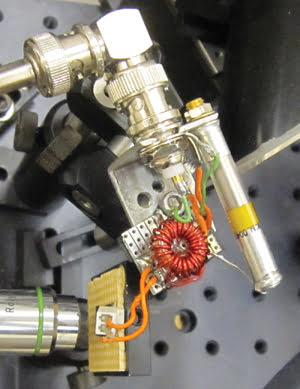
A new technique for terahertz radiation
A new laser-based source of terahertz radiation
that is more efficient and less prone to damage than similar systems could be useful
for detecting trace gases or imaging weapons in security screening.
Researchers at JILA, a joint institute of the National Institute
of Standards and Technology (NIST) and the University of Colorado, have developed
a technology that offers a twist on common terahertz sources.

The JILA instrument for generating terahertz
radiation. Ultrafast pulses of near-IR laser light enter the device through the
lens at the left, where the light strikes a semiconductor wafer studded with electrodes
bathed in an oscillating electric field. The light dislodges electrons, which acceleratein
the electric field, emitting waves of terahertz radiation. Courtesy of H. Zhang,
JILA.
The team used a semiconductor surface patterned with metal electrodes
and excited by ultrafast laser pulses. The scientists applied an electric field
across the semiconductor, while near-IR pulses lasting about 70 fs and produced
89 million times per second dislodged electrons from the semiconductor. The electrons
accelerated in the electric field, emitting waves of terahertz radiation.
To eliminate a common problem associated with the device, they
added a layer of silicon oxide insulation between the gallium arsenide semiconductor
and the gold electrodes, preventing any electrons from becoming trapped in semiconductor
crystal defects, which would produce spikes in the electric field.
Their innovation resulted in a uniform electric field over a large
area, which has enabled them to use a large laser beam spot size to enhance system
efficiency. Another advantage is that the technique does not require a microscopically
patterned sample or high-voltage electronics.
To generate terahertz radiation, systems using ultrafast lasers
and semiconductors are commercially important because they offer a combination of
broad frequency range, high frequencies and high-intensity output.
The system currently uses a large laser based on a titanium-doped
sapphire crystal, but it could be made more compact by using a different semiconductor
and a smaller fiber laser. NIST has applied for a provisional patent on the technique.
The research was described in
Optics Letters, Vol. 36, Issue 2,
pp. 223-225 (2011).
LATEST NEWS


